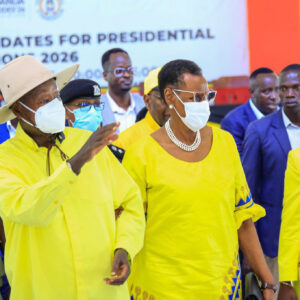President Yoweri Museveni has given his full backing to the ambitious Mbarara International Airport initiative during a meeting at State House, Entebbe. The proposal, driven by a China-based consortium led by Base 7 Aviation International Academy and their consultants Hamster Business Solutions, has been presented as a cornerstone of Uganda’s industrialization agenda and a catalyst for Western Uganda’s economic rise.
The planned airport is expected to serve as both a regional and international hub, linking Uganda to global markets while boosting trade, tourism, and agricultural exports. Representatives of the consortium, Mugabi Charles and Alexandria Judith Kyakunzire, described the project as a “game-changer” for Western Uganda, a region long recognized for its agricultural potential but underserved by major transport infrastructure. President Museveni echoed this optimism, calling the airport a “strategic project” that would create thousands of jobs, strengthen the agricultural value chain, and open the region to the world. “This is not just about planes landing and taking off,” he said. “It’s about bringing markets closer to our farmers, tourists to our landscapes, and opportunities to our youth.”
The project involves a three-way partnership bringing together global expertise in construction, design, and finance. Hunan Construction and Investment Engineering Company will oversee construction, China Southwest Architectural Design and Research Institute is handling feasibility and design, while Blackrock Uwekeza will finance and operate the airport under a Build, Operate, and Transfer model. Bethuel Macharia of Blackrock Uwekeza reaffirmed the firm’s commitment to fully fund the project, stressing its regional importance. “We see Mbarara International Airport as a catalyst for growth, not just for Uganda but for the entire East African region,” he said.
Consultants Eddie Kisitu and Abubakar Kaseruuzi of Hamster Business Solutions outlined a vision that stretches beyond national borders. They presented plans for Mbarara to serve as a transit hub linking Africa with Latin America, China, Indonesia, and Australia. By positioning the airport as a stopover for long-haul flights, Uganda could attract international carriers and generate significant foreign exchange earnings. The choice of Mbarara, located in the heart of Western Uganda and close to Rwanda, the Democratic Republic of Congo, and Tanzania, places it strategically to facilitate cross-border trade and regional integration while easing congestion at Entebbe International Airport.
While welcoming the project’s potential, President Museveni underscored the importance of environmental preservation in a region known for its national parks, fertile farmland, and fragile ecosystems. “We must build for the future, but we must also protect the land that feeds us,” he said. The consortium pledged to incorporate green technologies and sustainable construction practices while involving local communities in the planning process to ensure that the development reflects regional needs.
Construction is expected to begin once feasibility studies and detailed designs are complete. The airport is projected to be fully operational by 2030, aligning with the government’s Party and Term Oriented Delivery initiative. For farmers in Western Uganda, the project offers the promise of direct access to international markets for produce ranging from coffee to dairy. For the tourism sector, it is expected to open new gateways to attractions such as Queen Elizabeth National Park and Lake Mburo, while small businesses anticipate fresh opportunities tied to the influx of visitors and trade.
Still, challenges remain. Large-scale infrastructure projects in Uganda have often faced delays related to funding, land acquisition, and bureaucratic processes. Recent reports on land administration issues suggest hurdles may arise in Nyakisharara. Yet Museveni’s personal endorsement, combined with the strength of the international consortium, signals firm political will and investor confidence behind the initiative.
The Mbarara International Airport project comes at a time when Uganda is sharpening its focus on industrialization and sustainable development. At the recent Uganda Development Finance Summit, Museveni spoke of the need for “patient capital” and integrity in advancing national growth—a vision that this airport is intended to embody through long-term investment and public-private collaboration.
For Western Uganda, often overshadowed by Kampala and Entebbe, the project represents more than an infrastructure investment. It is a statement of inclusion in the country’s economic future. By 2030, the skies above Mbarara may well be alive with aircraft carrying goods, tourists, and new opportunities. As plans move forward, the nation’s attention will be fixed on Nyakisharara, watching closely as Uganda’s newest gateway to the world takes shape.





